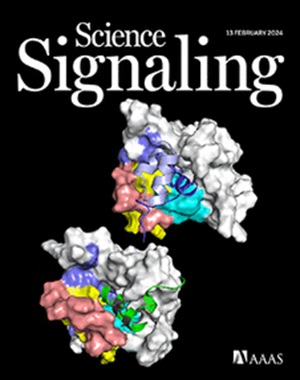功能缺失的Gαs罕见病变异体对GPCR信号通路具有突变特异性作用
IF 6.6
1区 生物学
Q1 BIOCHEMISTRY & MOLECULAR BIOLOGY
引用次数: 0
摘要
G蛋白偶联受体(gpcr)是细胞外信号的跨膜检测器,可激活异源三聚体G蛋白来调节细胞内反应。由于只有16种Gα蛋白可以与gpcr偶联,单个Gα的变异可以影响许多受体的功能。在这里,我们研究了与假甲状旁腺功能低下型Ic (PHPIc)相关的两种Gαs突变形式(L388R和E392K),这是一种母亲遗传的罕见疾病。g - αs由一个印迹基因编码,导致突变形式的g - αs是某些组织中唯一存在的蛋白质版本,从而导致组织特异性疾病的表现。通过整合三维结构、GPCR-G蛋白偶联特异性、转录组学、生物物理学和分子动力学数据以及系统药理学模型,我们确定了gpcr信号可能被肾脏中Gαs突变改变的gpcr,肾脏是参与PHPIc病理生理的组织。通过对甲状旁腺激素受体1 (PTH1R)激活G蛋白的分析发现,L388R破坏了Gαs与受体的相互作用,而E392K则降低了受体诱导的异源三聚体Gs的激活。这表明与同一疾病相关的特定Gαs突变可以改变不同的信号转导步骤。这些发现强调了研究GPCR信号中突变特异性扰动的重要性,以提出针对患者的治疗策略。此外,我们的方法为在不同生理和病理生理背景下询问GPCR信号多样性提供了蓝图。本文章由计算机程序翻译,如有差异,请以英文原文为准。
Loss-of-function Gαs rare disease variants exert mutation-specific effects on GPCR signaling
G protein–coupled receptors (GPCRs) are transmembrane detectors of extracellular signals that activate heterotrimeric G proteins to regulate intracellular responses. Because there are only 16 Gα proteins that can couple to GPCRs, variation in a single Gα can affect the function of numerous receptors. Here, we investigated two mutant forms of Gαs (L388R and E392K) that are associated with pseudohypoparathyroidism type Ic (PHPIc), a maternally inherited rare disease. Gαs is encoded by an imprinted gene, resulting in the mutant form of Gαs being the only version of the protein present in certain tissues, which leads to tissue-specific disease manifestations. By integrating data from three-dimensional structures, GPCR–G protein coupling specificity, transcriptomics, biophysics, and molecular dynamics with systems pharmacology modeling, we identified GPCRs whose signaling could be altered by Gαs mutations in the kidney, a tissue involved in the pathophysiology of PHPIc. Analysis of G protein activation by the parathyroid hormone receptor 1 (PTH1R) revealed that L388R impaired Gαs interaction with the receptor, whereas E392K reduced the receptor-induced activation of heterotrimeric Gs. This indicates that different signal transduction steps can be altered by specific Gαs mutants associated with the same disease. These findings highlight the importance of investigating mutation-specific perturbations in GPCR signaling to suggest patient-specific treatment strategies. Furthermore, our methods provide a blueprint for interrogating GPCR signaling diversity in different physiological and pathophysiological contexts.
求助全文
通过发布文献求助,成功后即可免费获取论文全文。
去求助
来源期刊

Science Signaling
BIOCHEMISTRY & MOLECULAR BIOLOGY-CELL BIOLOGY
CiteScore
9.50
自引率
0.00%
发文量
148
审稿时长
3-8 weeks
期刊介绍:
"Science Signaling" is a reputable, peer-reviewed journal dedicated to the exploration of cell communication mechanisms, offering a comprehensive view of the intricate processes that govern cellular regulation. This journal, published weekly online by the American Association for the Advancement of Science (AAAS), is a go-to resource for the latest research in cell signaling and its various facets.
The journal's scope encompasses a broad range of topics, including the study of signaling networks, synthetic biology, systems biology, and the application of these findings in drug discovery. It also delves into the computational and modeling aspects of regulatory pathways, providing insights into how cells communicate and respond to their environment.
In addition to publishing full-length articles that report on groundbreaking research, "Science Signaling" also features reviews that synthesize current knowledge in the field, focus articles that highlight specific areas of interest, and editor-written highlights that draw attention to particularly significant studies. This mix of content ensures that the journal serves as a valuable resource for both researchers and professionals looking to stay abreast of the latest advancements in cell communication science.
 求助内容:
求助内容: 应助结果提醒方式:
应助结果提醒方式:


